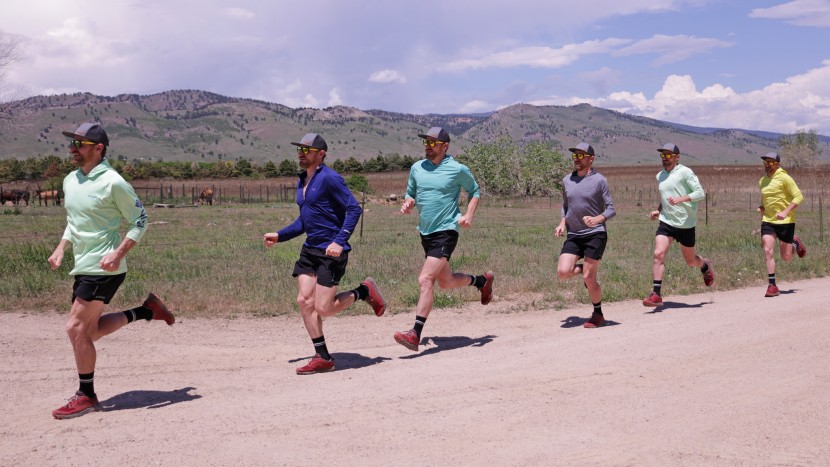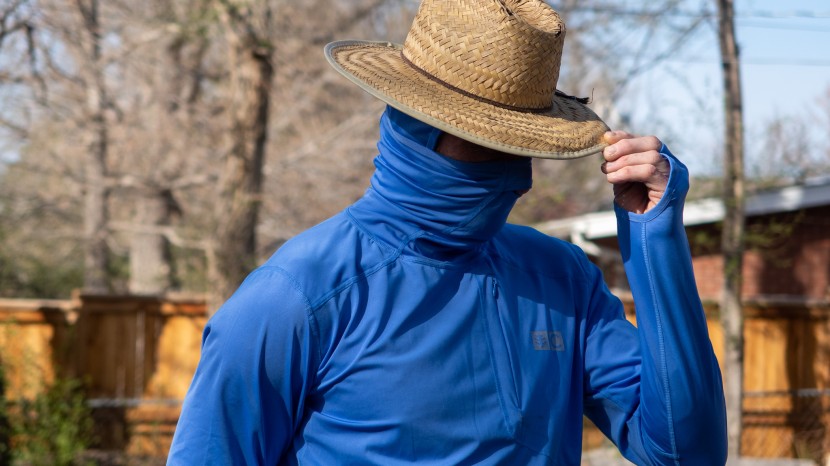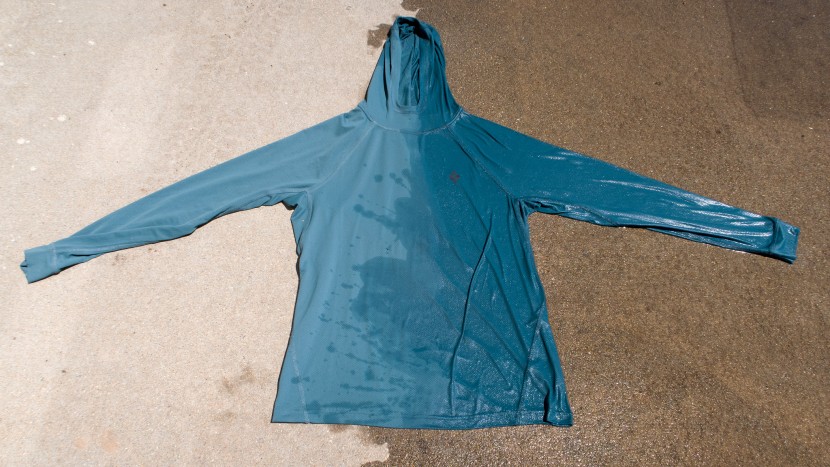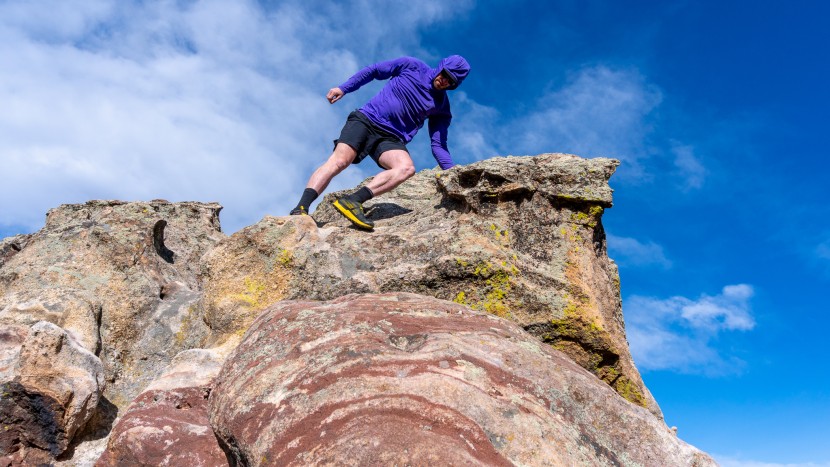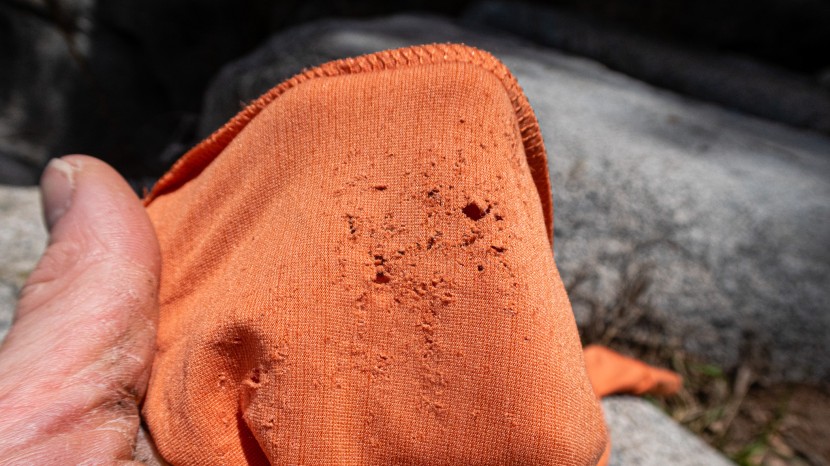Comfort and Fit
When a sun shirt fits well, you'll wear it more often. An ill-fitting garment will be left in the hamper or lost and forgotten in your closet. A sun shirt should also complement your own physique, allowing you to look presentable during a 0 day in town after five days on the trail, or even while at work at the office or during a Zoom call. While testing, we paid particular attention to how the shirts we reviewed felt when we wore them and how they moved with our body during all the activities we brought them along to do — which were plentiful. We ran, hiked, biked, climbed, goofed around, and even slept in them to see if they were comfortable enough to help give us a good night's rest.
Sun Protection
What good is a sun shirt if it can't protect you from its namesake? Sun shirts take on many different strategies to protect you from overexposure, and we compared all of them against each other to see which ones actually work. Some industry standards have been established to help compare different products, like the UPF (Ultraviolet Protection Factor) rating.
We tested the UV light penetration of each sun shirt using a simple, inexpensive photochromic UV intensity test card. We exposed each shirt to the noontime sun with the card underneath for approximately one minute. We then quickly removed the card to record the results of the UV-sensitive dye on the card itself, recording the results using a slow-motion video camera.
This test gives us a rough idea of how much UV light gets through the fabric (a small amount, a medium amount, a large amount), verifies manufacturer claims, and directly compares the protection of all sun shirts relative to one another. These cards are cheap enough for readers to reproduce our tests and verify our results. We used a thin cotton t-shirt as our control example of poor sun protection, which averages a UPF 5 rating. We also used a known UPF 50+ shirt to verify the top-end results.
But the effectiveness of this rating can still vary in real-world use because of the details of the shirts themselves: the cut and design, as well as what and where the shirt covers your body. If you bend down, does the shirt still cover your backside? Does the shirt work well all day and with a backpack filled with a week's worth of supplies? Is it comfortable enough that you'd even elect to wear it with the sleeves and collar/hood up? Are thumb loops useful, or do they just get in the way? We paid attention to each of these details while hanging out in the sun for hours to bring you the comprehensive details laid out in our review.
Breathability
A push-pull situation can occur in sun shirts: pieces that protect well may do so at the expense of breathability. Thick and tightly woven fabrics may win major points when it comes to their UPF rating but then may become so uncomfortable that they're unrealistic to wear during the hottest days or high-intensity activities. A shirt that's intolerable to wear may get left behind, which would completely miss the point of utilizing a sun shirt!
A great sun shirt may provide adequate protection from ultraviolet radiation and stay light and airy, allowing you to perspire naturally without becoming too sweaty. To fully test this metric, we hiked, biked, ran, and climbed extensively, all the while paying strict attention to our body temperature and how well we could keep it regulated via the fabric itself or by using some or all of the features of the shirt (sleeve tabs, vents, front buttons or zips, etc.)
We also did some work in the lab to test for air permeability and dry time. Air Permeability is closely related to the subjective feeling of “Breathability”. We tested this using a simple and inexpensive Peak Flow Meter, which measures the maximum force of air blown into it. We simply put the fabric we wanted to test between the source of this air (our mouths) and the device itself to record the airflow through each shirt's fabric.
Dry time was tested by recording each sun shirt's dry weight, washing them all together, and hanging them up to dry. We'd take each shirt off at given intervals and weigh them to record the weight and time throughout the drying process. Then, we compared each shirt's dry time to metrics like dry weight, type of material, etc.
Versatility
What's not to love about a piece of gear that can be used on the trails, at the pub, or even at work? We've worn the sun shirts in this review at every chance we could: hiking and running on the trails, climbing at the local crags, cycling up mountain passes to camp overnight at our secret spots, lounging around in the backyard, and even working at a busy lumber warehouse. These shirts have been smooshed into the bottom of packs, used for days on end in sweaty environments, scraped and abused off-trail through overgrowth and up rock formations, and been on many a mountain adventure at precipitous heights and dizzying cliff edges.
Durability
A well-designed, versatile, and great-fitting sun shirt may become your most relished piece of wearable gear, whether on the trail, by the river, at work, or at home. Before you fall madly in love with a piece of gear, you should know if it's committed to going the distance with you.
We've pulled no punches when wearing these sun shirts as much as possible for as many tasks as is realistic to do so. We've monitored each shirt for weaknesses in their stitching and any shortcomings in their design and features. Every shirt was worn under a backpack, exposed to many hours of direct sun, soaked with perspiration, packed, rolled, and left to dry in sunny breezes.
We also did a more controlled lab test, pitting each shirt against an abrasive piece of sandstone to see what sort of damage would be inflicted by such abuse.

